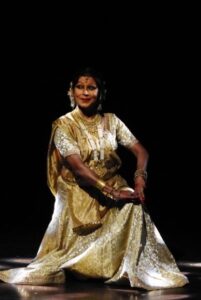Shovana Narayan’s ‘Kathak Lok’ documents 19 Kathak villages of India

She is an artist who has won our hearts for decades now, be it through her dance, her lectures, her philanthropically work or her writing. Padma Shri Shovana Narayan is one dancing legend whose work is totally unmatched. Her new offering to the world of dance is her latest book Kathak Lok’ We all have read and appreciated her numerous books but why is this book extremely special to her? Read on to know more about it:
So, why Kathak Lok?
The journey started in 2003 when, after a performance of mine in the Bodh Gaya Festival, a journalist asked me whether I would be visiting the Kathak Village. Hearing that a village was called Kathak aroused my curiosity and I set about finding the reason behind the name of the village being named thus. Over a decade later, I got to know that there were nine Kathak Villages in the country and each had been documented in the Census of India and assigned village codes. My eagerness mounted, which set me off on a serious in-depth research, which led me to find 19 Kathak villages, 15 of which are in located in central and eastern part of Uttar Pradesh and four in Bihar. Surprisingly, I was unable to locate any village by the name of Kathak in Rajasthan.
Tell me a bit about the research that went into the book?
The knowledge of existence of several Kathak villages in eastern Uttar Pradesh and Bihar caused wonderment and also a desire to understand what it was all about. In this context, what did the term Kathak indicate and whether existence of a group of Kathak dancers could lead to the settlement of a village, became the central points of consideration. The issues before us were several such as:
♦ Why were the villages called after Kathak? What did the plethora of Kathak villages indicate? After all, Kuchipudi dance form owes its origin to just one village but here, not less than eight Kathak villages had surfaced. Was there a likelihood of others also being uncovered in the near future?
♦ Was it also possible that in spite of a number of Kathak practitioners coming from a particular region, there would be no villages named after their vocation? If so, why? Was it because they did not belong to the community of original Kathaks?
♦ Who were the Kathaks? How did the term originate? What was the difference between Kathak and Katthak?
♦ All dance forms, whether in India or around the globe re-told stories (katha), so why they were not called Kathak (in the Indian context) and why was Kathak called Kathak? What was so special about the Kathaks of northern India? If the dance form, according to popular perception originated in the Mughal courts, then why did the dance form not become known by a name that had links to Persian or Arabic etymological roots and why then was it called Kathak with such a Sanskrit based etymological root?
♦ How and when did the villages come about? Why were there no Kathak villages near the four centres that have given rise to the two more practiced and known Kathak gharanas of today, namely Lucknow gharana and Jaipur gharana? Did these Kathak villages still have few Kathaks residing in the area along and what could have been the causes of migration?
♦ In the caste-ridden Indian society, what was their social status in terms of caste hierarchy? Unlike other dance forms, here was a dance form that sported a name which etymologically also was applicable to an occupation. It was hoped that the village survey would provide some light to the question of the evolution of Kathak as a group of artistes and as a dance form.
♦ What was the relationship between the Kathaks, the dancing girls and the patrons?
♦ Where and what kind of performances did the Kathaks of these villages do? How different is it from the Kathak dance as we know today?
Teacher, writer, performer, mentor, guru, activist you wear many caps, why a writer’s cap is special to you?
I like sharing knowledge, whether it is through performances, teaching dance, through lectures and books etc. These writings and the process of penning down my thoughts and experiences, enrich my understanding. They propel me to journey further inwards, seeking answers to several questions emotions evoked, to discover meanings that go beyond the surface of the words themselves. In such a voyage, the challenge is to go beyond popular perceptions and narratives that may be tinged with biases and prejudices, and base one’s acquired knowledge on archival records and historical details.
Kathak Lok edition 1 was well received now edition 2 is on its way, could please put some light on it?
I was extremely happy to see the tremendous response to the book Kathak Lok and was equally surprised when I was informed by the publisher that its second edition was on the way and whether I would like to add anything. The knowledge of a living temple tradition of the Kathak Lok, the existence of several Kathak villages recorded in official records, all of which have been existing right under our noses – was enriching to the reader as well as to me. This book has highlighted aspects that have never caught the attention of the urban society, nor of historians and litterateurs, in spite of official records and historical, archival documentary proofs of their existence and of living practices, which only indicates the treasure of knowledge of practices that this rich country of ours has nourished for ages and continues to nourish, that call for further enquiry.





